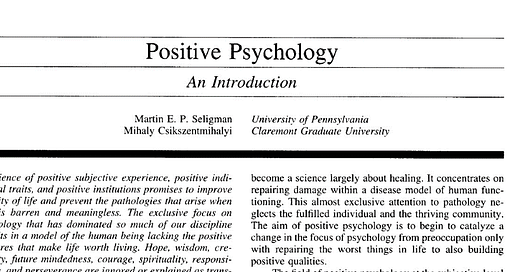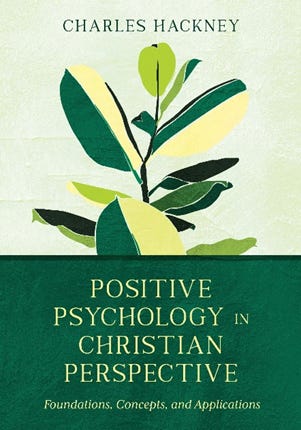Hello all.
Today I take off my Fiction Writer Hat and put on my Psychology Professor Hat, and spend a few minutes talking about one of my primary areas of focus within the field.
While we could put the official birthdate of the Positive Psychology Movement in 1998, when Martin Seligman gave his presidential speech to the APA, most of us got our first look at the psychology of happiness in the January 2000 issue of American Psychologist, and Seligman’s article “Positive Psychology: An Introduction,” co-written with Mihaly Csikszentmihalyi.
Given that we are now in January of 2025, I thought that this would be a good time to pause and take stock of how things have been going.
Positive psychology was introduced as a corrective to the largely-negative bent of the field of psychology. In the wake of two world wars, the lion’s share of attention and resources in 20th-Century psychology went toward helping people who were suffering. Relieving distress is not a bad thing, but it is incomplete as an approach to the human condition. There is more to life than repairing damage, there is also building strength, but topics such as happiness and flourishing were sidelined in favor of identifying and treating problems (Old-school happiness researcher Ed Diener relates a tale in which he got blocked for promotion at his university because he was supposedly wasting everyone’s time trying to understand what makes happy people happy instead of doing “important” work).
To restore balance to the field, Martin Seligman proposed that we begin to put more emphasis on three topics:
(1) positive subjective experiences.
(2) positive individual traits
(3) positive organizations and communities
Later, Gable and Haidt summarized positive psychology as “the study of the conditions and processes that contribute to the flourishing and optimal functioning of people, groups, and institutions.”
Since the launch of the movement, positive psychology has taken off in popularity. Positive psychology has been embraced by researchers and practitioners, and has found application is counseling, education, the workplace, the military, and public policy. Flourishing has become a hot topic, to the point that I see positive psychology products being hawked whenever I walk into my local Walmart:
This is how you know you’ve succeeded. When somebody tries to make a quick buck off of your work.
Try not to judge the serious scholarship of positive psychologists by the cheesiness of the self-help products that swim in our wake.
Two years after the introduction in American Psychologist, the first positive psychology book was published: Seligman’s Authentic Happiness. This was followed two years later by the first scholarly volume on the topic: Character Strengths and Virtues. The year after that, the University of Pennsylvania launched a Master’s degree in Applied Positive Psychology, which was followed two years later by the first doctoral program in positive psych, at Claremont Graduate University.
My own small contribution to positive psychology began around twenty years ago. As an undergraduate, I had minored in philosophy, doing specialized study in virtue ethics, so I already had flourishing on the brain. Because of that, when I came across that January 2000 special issue of American Psychologist, I was hooked.
My work in positive psychology has involved two specializations. The first involves the virtues and the martial arts. The idea of there being warrior virtues that elevate a practitioner to a higher level has deep roots across history and across cultures, as does the idea that the martial arts are a venue for personal growth. My publications have included an examination of the virtue of audatia in 15th-Century swordsmanship, and my 2010 book Martial Virtues.
My second specialization is more philosophical in nature, looking into the basic beliefs about human nature that shape the positive psychology movement, especially when compared/contrasted with Christian beliefs about the human condition.
I have written a bunch of scholarly articles on the topic, eventually leading up to my 2021 book Positive Psychology in Christian Perspective.
In my time working within the positive psychology movement, I have seen it explode from its early years of obscurity into international prominence. I have seen it accused of being a shallow fad (the Walmart thing hasn’t helped with that), a capitalist con job, an agent of tyranny, a false gospel, and a colonizing tool of Western imperialism. Truth be told, I have leveled a few criticisms at it myself; when I teach my Positive Psychology course, my students get whiplash watching me switch from the movement’s biggest cheerleader to harshest critic like some very odd kind of Jekyll-and-Hyde creature.
What is interesting about positive psychology at the quarter-century mark is that the excitement of the movement seems (in my eyes at least) to have settled down. Instead of being a collection of radical revolutionaries, positive psychology now seems mainstream. An examination of the past few years of publications like the Journal of Positive Psychology shows that most of what is currently going on involves adding complexity by considering cross-cultural differences and the upside of “negative” emotions, and working out the details of previously-established topics like gratitude, spirituality, and character strengths. I am tempted to see echoes of Thomas Kuhn’s distinction between the disruptive upheavals of scientific revolutions and the workaday labor of “normal science.”
Back in 2005, Gable and Haidt claimed that ultimately the future of positive psychology was for it to become “just plain psychology,” investigating human thought, feeling, and behavior in all its complexity and completeness. If the message of positive psychology in the 2020s is less “We’re radically upending everything!” and more “We are building a solid evidence base and embracing nuance,” then maybe the positive psychology movement might be thought of as having passed through our rebellious teenager phase and settled into adulthood.
Part of establishing oneself as an adult is finding the balance between keeping one’s roots and honoring family, and cultivating an independent identity. As positive psychology continues to mature, my hope is that we will see this less as The Seligman Show (while still honoring his foundational work), and fewer scholars content to cite Seligman’s publications as if they were authoritative.
As we hit this twenty-five-year mark, what are your thoughts on positive psychology? I would love to hear from you on topics like your experiences in this area (good and bad), your perceptions of the current state of the movement, and your hopes (and fears) for the future of positive psychology.









